Books
Books

On the Inconvenience of Other People
In On the Inconvenience of Other People Lauren Berlant continues to explore our affective engagement with the world. Berlant focuses on the encounter with and the desire for the bother of other people and objects, showing that to be driven toward attachment is to desire to be inconvenienced. Drawing on a range of sources, including Last Tango in Paris, Ralph Waldo Emerson, Claudia Rankine, Christopher Isherwood, Bhanu Kapil, the Occupy movement, and resistance to anti-Black state violence, Berlant poses inconvenience as an affective relation and considers how we might loosen our attachments in ways that allow us to build new forms of life. Collecting strategies for breaking apart a world in need of disturbing, the book's experiments in thought and writing cement Berlant's status as one of the most inventive and influential thinkers of our time.
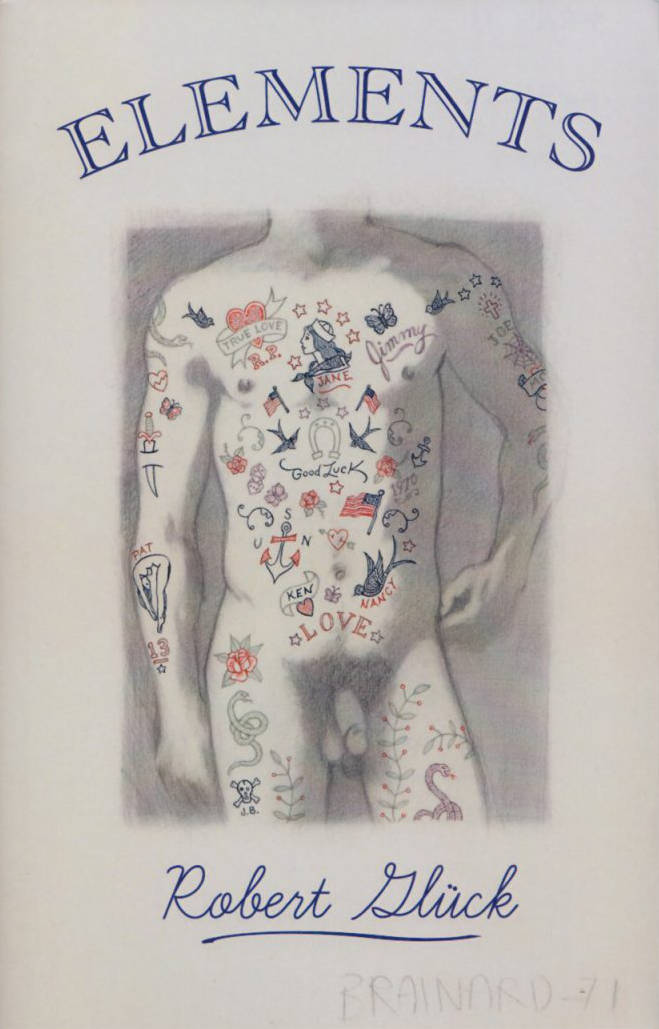
Elements
This collection of stories by Robert Gluck was originally published in 1982 in San Francisco by Four Seasons Foundation under the title ELEMENTS OF A COFFEE SERVICE.
"Bob's fiction is actually quite friendly yet he cuts it with a knife. Bob's gift to the history of letters I think is the uncanniness of his flow. He pulls down the page like a shade, it's masterful what he does. His page is more filled with light than words, really. More filled with temperature too." - Eileen Myles, from the preface to Elements

A Key Into the Language of America
The legacy of cultural imperialism, the consequences of gender, and the marginalization of the conquered are themes that combine and comment, one on the other, in Rosmarie Waldrop's remarkable new work, A Key into the Language of America. As "formally adventurous" (A.L. Nielson, Washington Review) as ever, German-born Waldrop has based her new collection on Rhode Island founder Roger Williams's 1643 guide (of the same name) to Narragansett Indian language and lore.
Rosmarie Waldrop, born in Germany in 1935, is the author of several books of poetry, fiction, and essays, and a noted translator of French and German poetry. Her most recent books are The Nick of Time, Gap Gardening: Selected Poems(winner of the Los Angeles Book Prize), and Driven to Abstraction. She is a member of the American Academy of Arts of Letters, and is a Chevalier of the Ordre des Arts et des Lettres. For fifty-six years, she and her husband Keith Waldrop ran one of the country's most vibrant experimental poetry presses, Burning Deck, in Providence, Rhode Island.
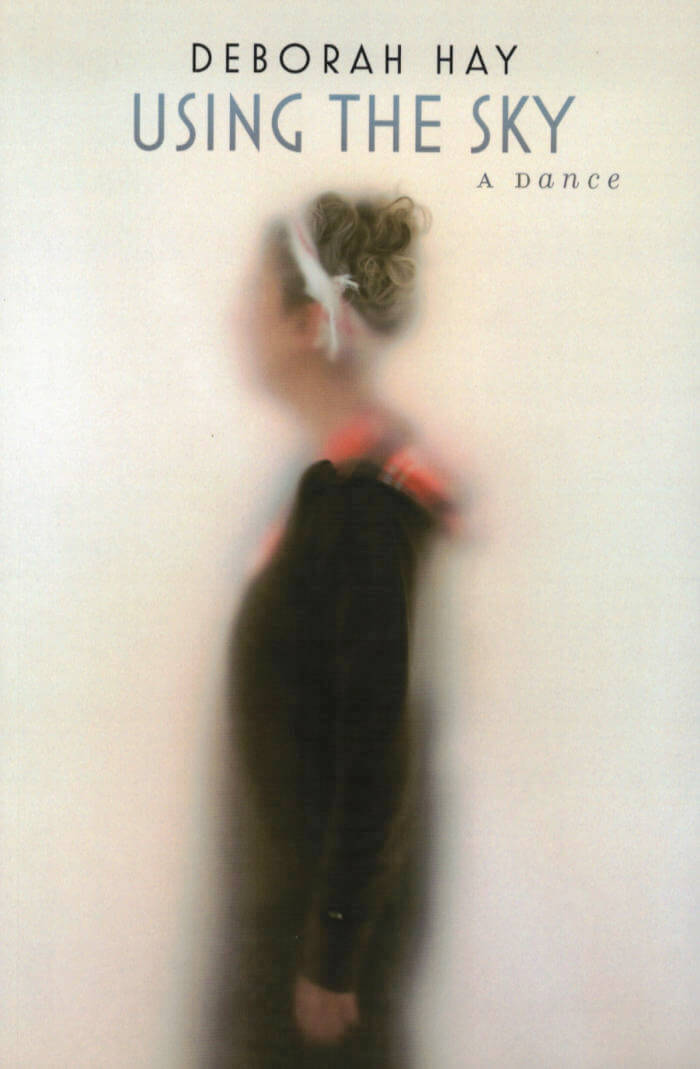
Using the Sky: A Dance
Using the Sky: A Dance explores Deborah Hay's choreographic imagery through a broad range of alternately intimate, descriptive, poetic, analytical and often playful engagement with language and writing.
Includes notes on four dances, If I Sing to You (2008), No Time to Fly (2010), A Lecture on the Performance of Beauty (2003), and the solo My Choreographed Body (2014)

Houses To Die In and Other Essays on Art
Art critical essays focusing on artworks that, in various ways, convey a sense of unheroic "trouble."
Stories of the undead of contemporary painting, the mediation of pain, photography courting stupidity, sculpture and architecture courting animism, populism in avant-garde art, fear of avant-garde territorialism, ambivalent networking, displaced abstractions and misplaced weather systems.
The essays assembled in this volume were all written over the past twenty years—a period in which Ina Blom pursued art critical writing alongside more academic work and when the boundaries between the two genres grew at times deliberately blurred. Dispersed as they were across a variety of publications with limited accessibility—out-of-print anthologies and artist's books, hard-to-find art catalogues, journals, and magazines protected by paywalls—Houses To Die In and Other Essays on Art at last brings them together, and not just for practical reasons. If the texts collected here have one thing in common, it is in a certain pull they display toward artistic projects that are not redemptive or exemplary, but which instead convey a sense of trouble: trouble actively sought by the artists or keenly felt by Blom. A distinctly unheroic trouble.
Born in Oslo in 1961, Ina Blom is an Associate Professor at the Department of Philosophy, Classics, History of Art and Ideas at the University of Oslo. She has written extensively on modern and contemporary art and is also active as an art critic.
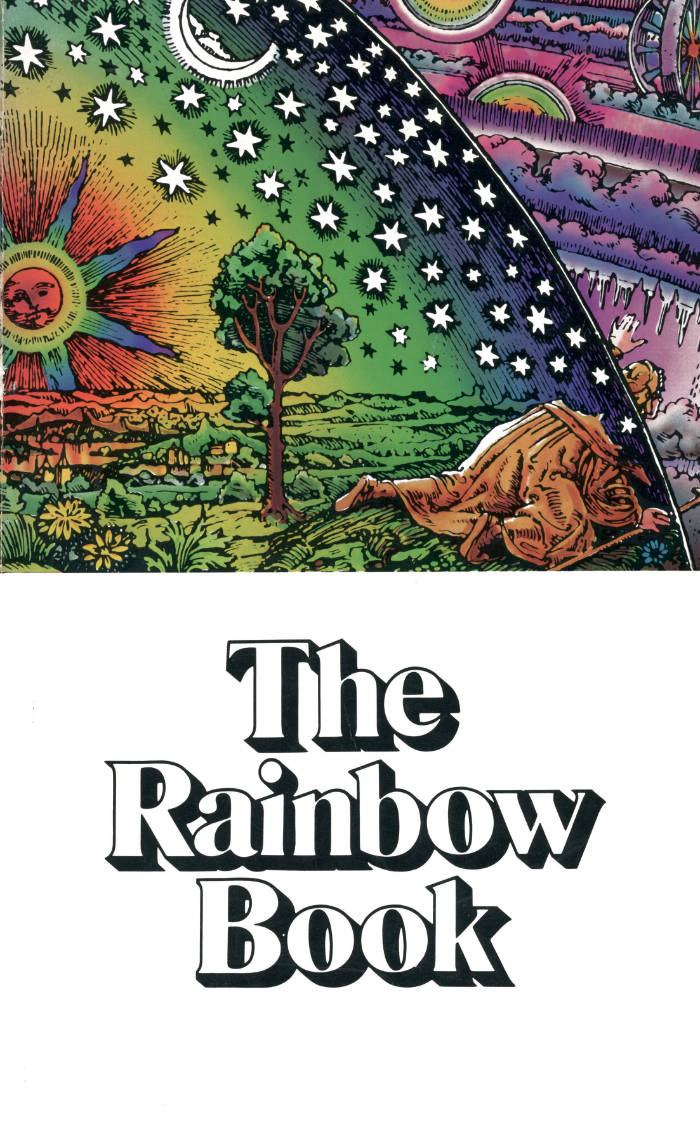
The Rainbow Book
F. Lanier Graham, Larry Wurn and 1 more
The book is a reprint of a cult text of post-1968 psychedelic culture: The Rainbow Book, published in 1975 in Berkeley, California, on the occasion of The Rainbow Show exhibition held at the Fine Arts Museums of San Francisco.
The Rainbow Book is a collection of essays and illustrations devoted to the rainbow and color spectra, analyzing the significance of color (both physical and metaphysical) from antiquity to modern times.
An encyclopedia of the cultural and artistic manifestations of the rainbow: in myth, magic and paintings, as well as in prints and poems. The book includes poems by Virgil, Dante, Blake, Keats, Wordsworth, and others; paintings by Giotto, Bosch, Van der Weyden, Dürer, Rubens, Blake, Turner, Constable, and Church; and the sacred art of Tibet.
The book is printed on sheets of different colors, according to the rainbow spectrum, and reports notions of increasing complexity, accessible at first to younger readers and later to the more experienced and interested in the subject.
The reprint accompanies the exhibition Rainbow. Colors and Wonders between Myths, Arts and Science at MUDEC in Milan (February 16–July 2, 2023), and the release of the first issue of MUdec United.

The Whisper
The Whisper is Félicia Atkinson's new artist's book, bringing together photographs, drawings and poems. They revolve around the eponymous installation located on the pointe d'Agon, on the west coast in Normandy. On a dune acquired by the artist for the Conservatoire du Littoral, stands a pierced wooden sculpture. Around this sculpture, inside this wild dune and facing the sea, the walker is invited to become a whisperer, and listen to what surrounds him.
What if whispering could be a metaphor for a way of creating and living within biodiversity? Observing and listening, being present to the world while only leaving gentle trace? The studio then becomes a garden, the exhibition space a dune, deep listening a method of working and exchanging with the public and the reader.
Experimental musician, sound and visual artist Félicia Atkinson (born 1981) lives on the wild coast of Normandy (France). She has played music since the early 2000s. She has released many records and a novel on Shelter Press, the label and publisher she co-runs with Bartolomé Sanson.
For Félicia Atkinson, human voices inhabit an ecology alongside and within many other things that don't speak, in the conventional sense: landscapes, images, books, memories, ideas. The French electro-acoustic composer and visual artist makes music that animates these other possible voices in conversation with her own, collaging field recording, MIDI instrumentation, and snippets of essayistic language in both French and English. Her own voice, always shifting to make space, might whisper from the corner or assume another character's tone. Atkinson uses composing as a way to process imaginative and creative life, frequently engaging with the work of visual artists, filmmakers, and novelists. Her layered compositions tell stories that alternately stretch and fold time and place, stories in which she is the narrator but not the protagonist.

LSD #03 – A DIY Issue
The third issue of Le Signe Design (the Cahiers of the National Graphic Design Center) is about DIY practices and is based on the work of Gilles de Brock, graphic designer who became a ceramic tile manufacturer.
Do It Yourself practices are not, as is commonly assumed, limited to home improvement, nor just a way of subverting—hacking—a given social and political organization. They are also a way of looking both forward and backward, at our future and our heritage. They involve our heritage insofar as they allow constituted groups to revive past knowledge and skills threatened with extinction. They look forward in that they make it possible to create tools that do not yet exist but could.
The applications of the Do It Yourself approach range from niche practices to everything everywhere, and what they have in common is that they are always in opposition to the mass market. Some examples of this extremely diversified movement include self-publishing, cosplay, biotechnology, hacking (especially in the sense of programming), and producing digital artworks and music. Its most mediatized (and often romanticized) contemporary manifestation is what are called fablabs, but this term is too limited to cover the phenomenon in all its vast variety.
The roots of the DIY movement go back to the magazines Popular Mechanics(1902) and Mechanix Illustrated (1928), popular education publications meant for readers in small towns and the countryside who needed to be self-reliant and repair broken manufactured items rather than buying new ones. The late 1960s saw the emergence of movements motivated by environmental concerns and a distrust of consumer society. Many people—like some student co-op members, hippies in North America and punks in Europe—wanted to share resources. Stewart Brand's famous Whole Earth Catalogue, subtitled "Access to tools", launched in 1968, constitutes our contemporary reference.
This issue is appearing in parallel with the solo exhibition retracing the career of Gilles de Brock, whose production is deeply infused with the DIY spirit. Yet his practice can't be reduced to the things he has actually made. It is part of the kind of knowledge-sharing economy proclaimed in Brand's counter-culture manifesto, able to go even further today thanks to the participatory and interactive Web 2.0.
Texts by Pao Lien Djie, Maya Ober, Nina Paim, Anthony Masure, Guillaume Helleu, Tereza Bettinardi, Jean-Michel Géridan.

Chroniques et poèmes sarcastiques à prendre au premier degré d'une gouine peut-être femme peut-être poète
How To Become est une maison d'édition autogérée basée à Paris. Nous publions les textes d'auteuces engagés dans des pratiques féministes et peu diffusés par le réseau des grandes maisons d'édition françaises.
Créée en 2016, elle est composée d'artistes et écrivaires en majorité gouines, HTB publie de la litterature expérimentale née d'influences post-post- sapphiques ainsi qu'un choix de tradu d'auteuices non traduites en langue française. HTB s'articule autour d'ateliers d'écriture: How to Become a Lesbian, et d'une revue annuelle publiant les choses issues de l'atelier.

Le magasin
How To Become est une maison d'édition autogérée basée à Paris. Nous publions les textes d'auteuces engagés dans des pratiques féministes et peu diffusés par le réseau des grandes maisons d'édition françaises.
Créée en 2016, elle est composée d'artistes et écrivaires en majorité gouines, HTB publie de la litterature expérimentale née d'influences post-post- sapphiques ainsi qu'un choix de tradu d'auteuices non traduites en langue française. HTB s'articule autour d'ateliers d'écriture: How to Become a Lesbian, et d'une revue annuelle publiant les choses issues de l'atelier.

Néo-chatte
How To Become est une maison d'édition autogérée basée à Paris. Nous publions les textes d'auteuces engagés dans des pratiques féministes et peu diffusés par le réseau des grandes maisons d'édition françaises.
Créée en 2016, elle est composée d'artistes et écrivaires en majorité gouines, HTB publie de la litterature expérimentale née d'influences post-post- sapphiques ainsi qu'un choix de tradu d'auteuices non traduites en langue française. HTB s'articule autour d'ateliers d'écriture: How to Become a Lesbian, et d'une revue annuelle publiant les choses issues de l'atelier.

Barking Up the Wrong Tree
How To Become est une maison d'édition autogérée basée à Paris. Nous publions les textes d'auteuces engagés dans des pratiques féministes et peu diffusés par le réseau des grandes maisons d'édition françaises.
Créée en 2016, elle est composée d'artistes et écrivaires en majorité gouines, HTB publie de la litterature expérimentale née d'influences post-post- sapphiques ainsi qu'un choix de tradu d'auteuices non traduites en langue française. HTB s'articule autour d'ateliers d'écriture: How to Become a Lesbian, et d'une revue annuelle publiant les choses issues de l'atelier.

Deleuzine Volume 2: She-Dogs
Deleuzine: A Zine for Nobodies Without Organs is an experimental publication inspired by the writings of French philosopher Gilles Deleuze, as well as figures whose life or work can be said to exemplify aspects of Deleuze’s philosophy of life, including Antonin Artaud, Ezekiel Mphaphele’s Wanderers and Kathy Acker among others. Encompassing the fields of literature, philosophy, ethnography, archaeology, and the arts, the publication aims at a radical exploration (and exploitation) of word, image, and printed matter towards beauty, but also aesthetic and political freedom.
1 Laurence Pritchard, Memories of the Penes 6 Natascha Nanji, Crisis in Three Parts 16 Max Henninger, From Poems For Two Voices 18 Sascha Akhtar, Now, You Become D/eath, Destroyer 34 Karina Bush, Claws; I Spit; Sonnet VI 36 Francesca Dobbe, Dog Lady’s Becoming Animal 9 George Micah Kuhn, Pharmacophilia 54 Uma Breakdown, The Graveyard of Extension 60 MUCK, ‘IN A FOLD, THE OUTSIDE IS NEVER FULLY ABSORBED…’ 73 Anouk Asselineau, Angel’s Share 78 Maria Sledmere, Zebra; Lens Flare; Sophie Ellis-Bextor’s Kitchen Disco; Jewel Organza; New Weird Kirsty 82 Paola Valentina, Tube people 85 Dalia Maini, Water Lilies Syndrome 88 Hugo Hagger, Death Dissensus 95 Michal Leszuk, Curating Cruising Culture in the Anthropocene 108 Joshua Jones, Petřín Hill, Dusk 111 Chiara Gambuto 143 Isaac Harris, Helioelagablaus Reborn 163Helen Samuels, Winterize 174 Aimilia Efthimiou, A Recipe 176Simon Barraclough, Vampire in the Funhouse, Part I 178 Suki Hollywood, Mortal Combat 186 Louis Mason, The Executioner 198 Rebecca Close, The Acephale Sonnets 204Sites Of Horror RU, RmIH8 U 90’s Ancestors 206 MUCK, THE STORM 215 George Finlay Ramsay, Raven’s Reprise 228Mike Templeton, The Window Journal: Looking out my Window onto Court Street 232 Caitlin Merrett King, She Has No References; Dylan Thomas; For S 235 Phoebe Eccles, Hold Me in Your Watchful Presence 238 Isabelle Bucklow, Some Bears, Some Moves 244 Alistair McCartney, The Textual Animal 248 Caspar Bryant, Diffraction of a Waterfowl 249 Flo Josephine Goodliffe, Alive Border (Husk or Shell) front & back cover(s) Jean-Robert Alcindor (dispersed) drawings by Rossen Daskalov designed by Alessia Arcuri

Paradis catalogue
Contributions by: Nicole-Antonia Spagnola, Georgia Sagri, John Kelsey, Matthew Pang, Cathy Wilkes, Sarah Rapson, Nick Irvin, Gene Beery, Anne Dressen, Anne Pontégnie, Jacqueline Mesmaeker, Sara Deraedt, Anne Rorimer, Kari Rittenbach, Olga Balema, Maria Nordman, Louise Lawler, Julie Ault, Martin Beck, Adrian Morris, Matt Browning, John Miller, Envers Hadzijaj, Enzo Shalom, Bedros Yeretzian, Morag Keil, Helmut Draxler, Gianna Surangkanjanajai, Steve Cannon, Rae Armentrout, Zoe Hitzig, Pierre Guyotat, Lola Sinreich, Fanny Howe, Hélène Fauquet, Marie Angeletti, Richard Hawkins, Andy Robert, Alexander García Düttmann, Daniel Horn, El Hadji Sy, Henrik Olesen, Aurélien Potier, Richard John Jones, Stéphane Barbier Bouvet, Nora Schultz, Peter Fend, Megan Francis Sullivan, Jill Johnston, Sturtevant, Tonio Kröner, Bernard Bazile, Pierre Bal-Blanc, Jérome Pantalacci, Gérard Traquandi, Gladys Clover, Maria Wutz, Jimmie Durham, Richard Sides, Camilla Wills, Michael Callies, Steven Warwick, Matthew Langan-Peck, Dan Graham, Nina Könnemann, Hans Christian Dany, Valérie Knoll, Win McCarthy, Eleanor Ivory Weber, Anna Rubin, Heji Shin, Michèle Graf & Selina Grüter, Inka Meißner, Simone Forti, Morgan O’Hara, Angharad Williams, Ye Xe, Lily Van Der Stokker, Yuki Kimura, Peter Wächtler, Eva Steinmetz, Michael Van den Abeele, Marc Kokopeli, Bradley Kronz, Robert Grosvenor, Samuel Jeffery, Charlotte Houette, Adam Martin, Wade Guyton, Chloe Truong-Jones.
Edited by Marie Angeletti with Gianmaria Andreetta and Camilla Wills.
Printed in December 2022.
416 pages, Edition of 840.
© 2022 Claude Balls Int. / the author(s).

Against Ageism: A Queer Manifesto
Age! What is it good for? Absolutely nothing! (Apart from greasing the wheels of capitalist reproduction.) In this queer manifesto, Simon(e) van Saarloos weaves a wealth of militant sex-liberationist, afrofuturist, transfeminist and decolonial imaginaries into their anti-ageist sails, charting a confident course across contemporary society’s generational hang-ups as well as visiting, in some more personal moments, their own.
-Sophie Lewis, author of Abolish the Family: A Manifesto for Care and Liberation and Full Surrogacy Now: Feminism Against Family
Against Ageism: A Queer Manifesto starts with what it is not: it is not a socio-economic argument against ageism, celebrating “the elderly” as economically viable. Author Simon(e) van Saarloos is not interested in natural arguments about age, which portray different age groups as valuable because of assumed inherent qualities. Instead, this manifesto starts with an experience of childhood sexual abuse, and moves on to dissect the ways in which constructions of “age” and “youth” function to support and reproduce white supremacist patriarchy. The book includes two reproductions of works by painter Samantha Nye.
Simon(e) van Saarloos is the author of Take ‘em Down (Publication Studio Guelph) and Playing Monogamy (Publication Studio Rotterdam). They were the curator of the 2021 exhibition on Abundance (“We must bring about the end of the world as we know it” – Denise Ferreira da Silva) in Het HEM and are also the host of *The Asterisk Conversations podcast. Van Saarloos is currently a PhD candidate in the Rhetoric department at UC Berkeley.

Inserts in Real Time: Performance Work 2000–2023
'Inserts in Real Time' is the first monograph on the performance work developed by artist Dora García over the past twenty years. The book contains a conversation between the artist and curator Joanna Zielińska; a selection of her performance scripts; her performances to date, listed, illustrated, described, and contextualized; and three newly commissioned texts – by art historian Sven Lütticken, performance theorist Bojana Cvejić, and Dora García. The publication is co-published with M HKA, Antwerp, and accompanies Dora García’s exhibition 'She Has Many Names'.

Fieldnotes: Issue 4
The fourth issue of FIELDNOTES contains new work by:
Adeola Titiloye, ajw, Fanny Howe, Will Alexander, Michael O’Mahony, Agnieszka Szczotka, Renee Gladman & Isabel Mallet, Can Xue, Karen Gernant & Chen Zeping, Tony Brooks, Nwuguru Chidiebere Sullivan, Mat Jenner, Alba Schloessingk, Camille Roy, Pete Segall, Johanna Hedva, Beihua Guo, Cedar Sigo, KP Culver
FIELDNOTES is an artist-run publishing project based in Newham in east London, aiming to promote and support non-conforming creative practices that pioneer new cultural forms.
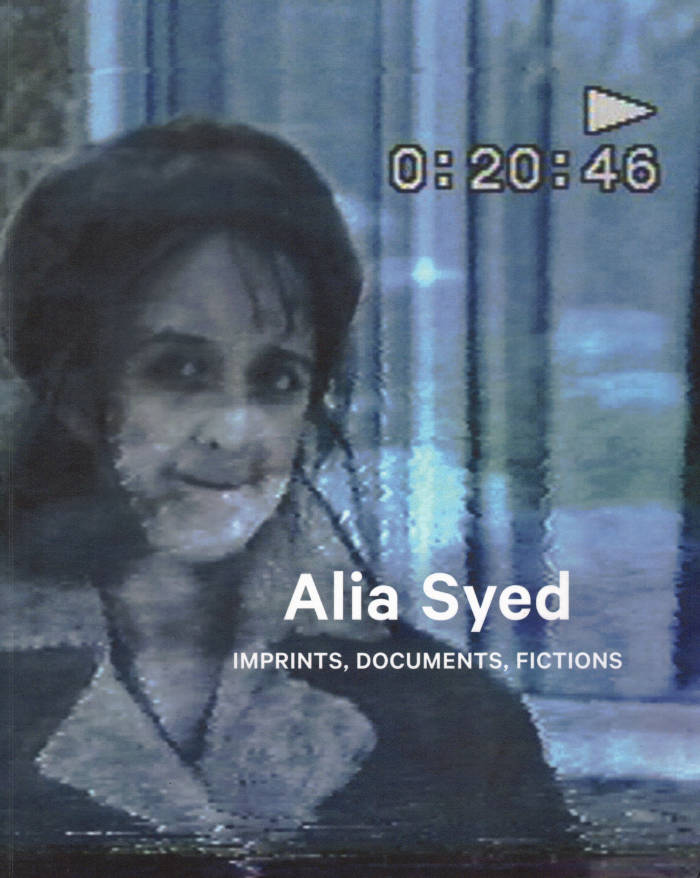
Alia Syed: Imprints, Documents, Fictions
Published by Courtisane festival in collaboration with Open City Documentary Festival, Alia Syed: Imprints, Documents, Fictions (ed. María Palacios Cruz) is the first monograph to be devoted to Syed’s work and features new essays by Jemma Desai, Inga Fraser, Peter Gidal, Rahila Haque, Salima Hashmi, Anjana Janardhan, Ruth Noack and Henrietta Williams, as well as writing by Syed herself.
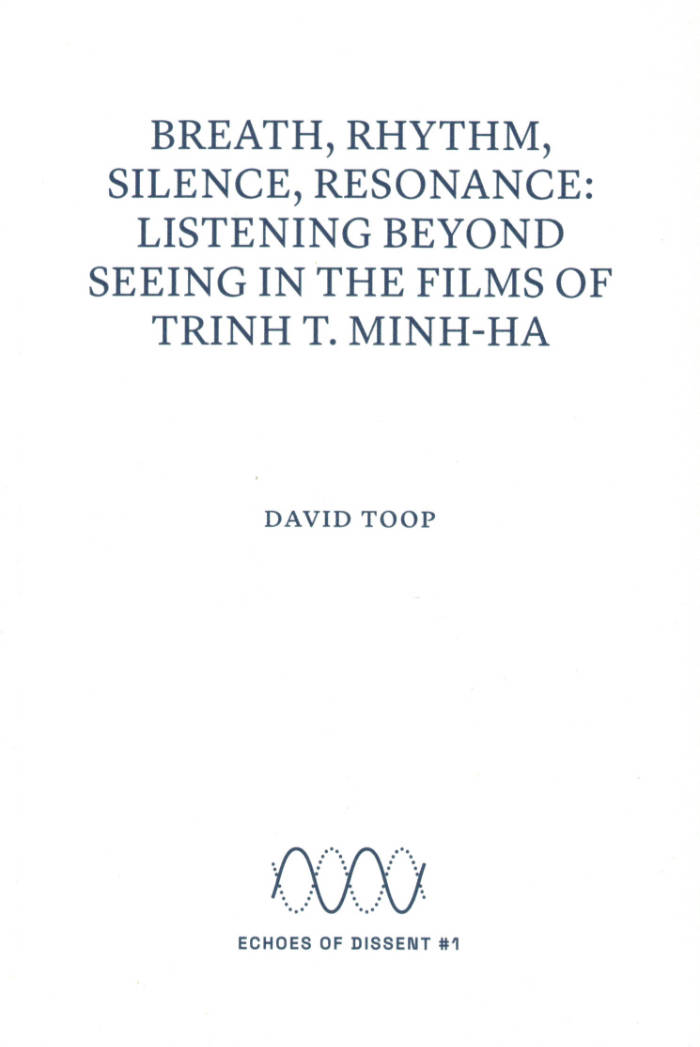
Breath, rhythm, silence, resonance: listening beyond seeing in the films of Trinh T. Minh-ha
In the context of the Artist in focus Trinh T. Minh-ha program at Courtisane festival 2023, Courtisane invited musician, author and curator David Toop to reflect on the sound work in her films. The resulting publication, titled Breath, rhythm, silence, resonance: listening beyond seeing in the films of Trinh T. Minhha, is the first publication in the Echoes of Dissent series, devoted to the politics of the soundtrack.

Things To Do With Your Mouth
Attempts to control the mouths of "speaking women"—17th century witches, 19th century hysterics—have taken many forms, both physical and metaphorical.
In Things To Do With Your Mouth, Divya Victor repeats, recants, and relentlessly echoes a textual meeting place for the psychic and corporeal implications of this "fear of women with excessive powers of speech and discourse," creating a cacophonous movement towards the feminist purpose of poetics. Culling language from texts as diverse as nursery rhymes and contemporary pediatric health websites, the biblical Song of Solomon and Freud's "Analysis of a Case of Hysteria," Victor confronts this long history of the "silenced mouth." Section by section, appropriated word by appropriated word, Victor relishes in the buccal opening, its capacity for words and discourse, addressing Nietzsche's claim that the world "lives on itself: its excrements are its nourishment." These words will "eat you alive, digest you, leave you scattered." Or, as CA Conrad states in his afterword, these reutterances will ultimately "liberate" us "one cough at a time. The mouth in, the mouth out, mouths training mouths around the always-imperfect O."
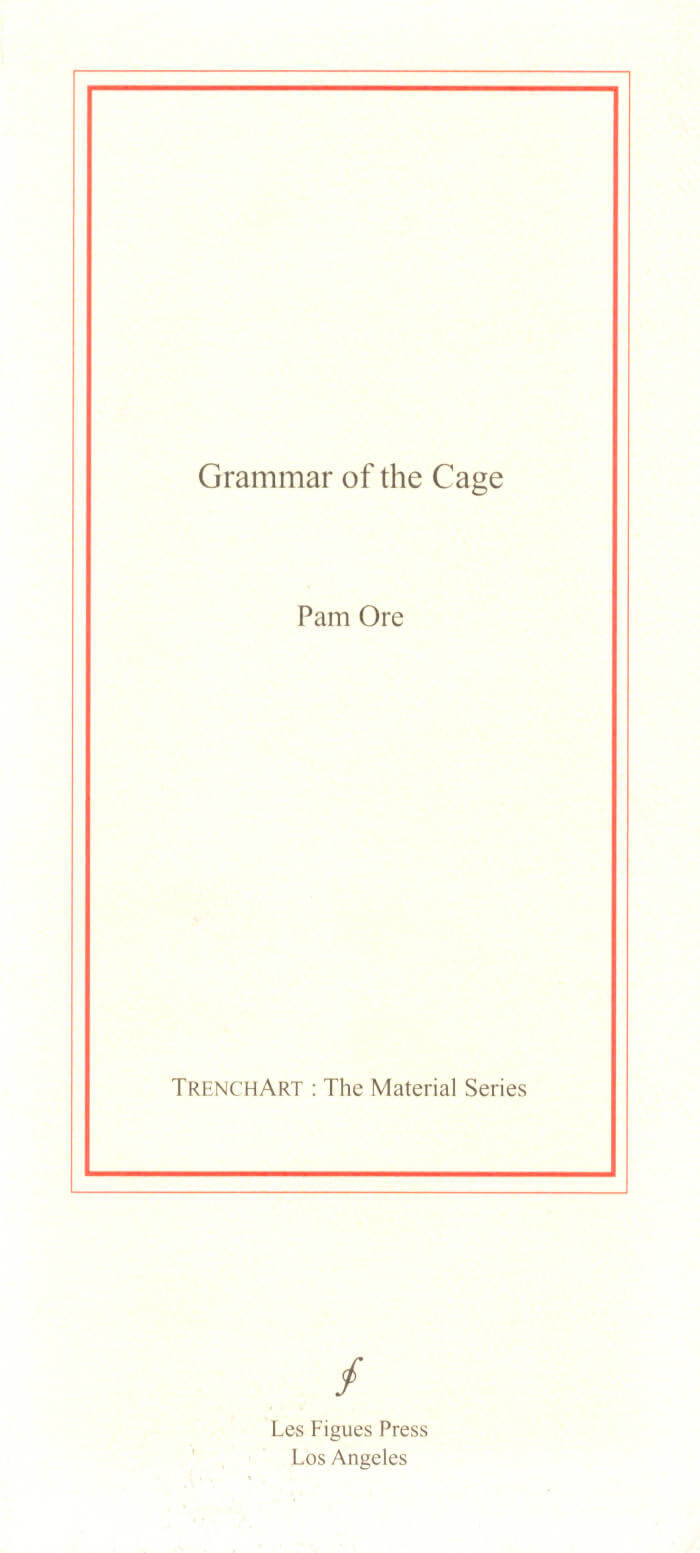
Grammar of the Cage
What words made this world of captivity and extinction? If written language is a biological adaptation, how can a text reshape the environment? These are the questions at the heart of Grammar of the Cage, a startling first collection of poetry by Pam Ore. The Compulsive Reader calls Ore "a poet of great promise," and poet Eloise Klein Healy says she has found Ore's book "haunting but necessary...a stunning debut collection."
Grammar of the Cage is clean and heartbreaking as a bone, and yet, as poet Ingrid Wendt writes in her Introduction, "[like] Emily Dickinson, Ore's 'business' is 'to sing.' And sing she does."

Hidden in the Cave We Forge of One Another
Hidden in the Cave We Forge of One Another gathers a selection of CAConrad’s soma(tic) poems, written from rituals performed by the author, which call for a state of consciousness grounded in the now and an awareness of bodies, their environmental entanglements and social histories. This is a poetry for surpassing, politically charged yet meditative and quotidian. CAConrad's poetry is rooted in legacies of both struggle and friendship arising from the AIDS crisis, as well as in contemporary imaginations of belonging in an ecologically broken world. This selection of poems is accompanied by an extensive interview with the author, complete with photographs and transcripts, as well as the theater play The Obituary Show. This publication accompanies Hidden in the Cave We Forge of One Another, an exhibition by CAConrad, curated by pântano books and commissioned by Batalha Centro de Cinema.
CAConrad has worked with the ancient technologies of poetry and ritual since 1975. They are the author of nine books, including AMANDA PARADISE: Resurrect Extinct Vibration (Wave Books, 2021), which won the 2022 PEN Josephine Miles Award. They received a 2022 Ruth Lilly Poetry Prize, a Creative Capital grant, a Pew Fellowship, and a Lambda Award. They exhibit poems as art objects, with recent solo shows in Spain and Portugal, and their play The Obituary Show was adapted into film in 2022 by Augusto Cascales. UK Penguin published two books of theirs in 2023, The Book of Frank and You Don’t Have What It Takes to Be My Nemesis, and a new collection of poetry is forthcoming from Wave Books in 2024, titled Listen to the Golden Boomerang Return. This publication accompanies Hidden in the Cave We Forge of One Another, an exhibition by CAConrad, curated by pântano books for Batalha Centro de Cinema in 2023. You can visit CAConrad online.
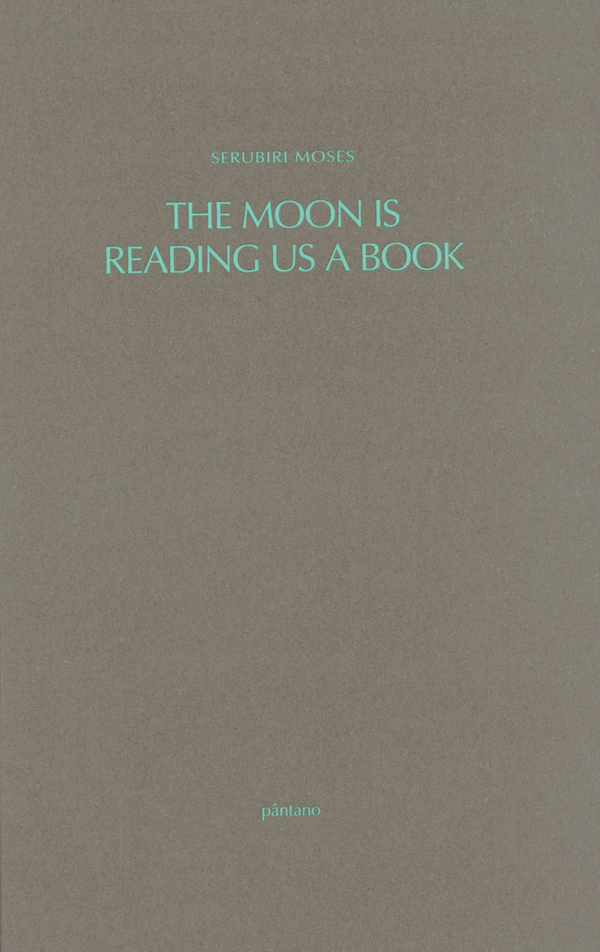
The Moon is Reading us a Book
THE MOON IS READING US A BOOK is the debut collection of poetry from a writer who displays a wide-ranging palette for storytelling and folklore in a suite of narrative poems. The collection is built around an ensemble of characters that range from known to unknown, through which Serubiri crafts visually-inspired poems that combine the photographic, the intensely personal, and the scholarly. In his book, he manages to domesticate larger-than-life figures, including Zanzibari-born singer-songwriter Freddie Mercury and Nigerian-born photographer Rotimi Fani Kayode. Simultaneously pondered and elastic, Serubiri’s poetry lures these figures – and the reader – into an atmosphere that is only as expansive as the interior landscapes he delineates with each succeeding poem. With this he expresses his own doubts and path, from memories of his native Uganda to New York City, through a psychology of decisions and life choices.
Serubiri Moses is a Ugandan curator and author based in New York City. He currently serves as faculty in Art History at Hunter College and visiting faculty at the Center for Curatorial Studies, Bard College. He previously held positions at New York University and the New Centre for Research and Practice, and delivered lectures at Williams College, Yale University, University of Pittsburgh, The New School, basis voor aktuelle kunst, and University of the Arts Helsinki. As a curator, he has organized exhibitions at museums including MoMA PS1, New York; Kunst-Werke Institute for Contemporary Art, Berlin; and the Hessel Museum, Bard College, NY. He previously held a research fellowship at the University of Bayreuth; received his MA in Curatorial Studies at Bard College; and is an alumni of the Àsìkò International Art Programme. He serves on the editorial team of e-flux journal. He has published poetry in the online journals Jalada and Badilisha Poetry Exchange, as well as in print in journals Kwani? 7, Kwani? 8, and READ: A Journal of Inter-Translation (2022). His poetry has been reviewed online in The New Inquiry. THE MOON IS READING US A BOOK is his first book of poetry.

Valley of the Many-Colored Grasses
Ronald Johnson's underground classic of visionary and queer poetics, Valley of the Many-Colored Grasses, has been legendarily hard to find for over 50 years.
In this book of poems, Johnson creates a specifically North American vision that references everything from ancient Native American myths to Johnny Appleseed, from Charles Darwin to the Wizard of Oz, microcosmically transforming the vast open expanse of the plains into delicate flower petals.
These are poems of observation, transformation, and a uniquely subtle sensibility harmonically tuned to the stars. Masterfully crafted examples of poetic music and textures, Johnson weaves together texts to show the world from multiple angles of vision, not only his own, to explore what others have seen and experienced of the world.
One of the most unheralded poets in literature, Ronald Johnson needs to be securely placed in history with the likes of his fellow dreamers: Stan Brakhage, Marguerite Young, Charles Ives, Marsden Hartley, and the Transcendentalists.